
Photo from wikipedia
We report the coordination chemistry of indole based tripodal tetraphosphine ligands to iron(II), cobalt(II) and nickel(II). These complexes are formed by simple synthetic protocols and were characterized by a combination… Click to show full abstract
We report the coordination chemistry of indole based tripodal tetraphosphine ligands to iron(II), cobalt(II) and nickel(II). These complexes are formed by simple synthetic protocols and were characterized by a combination of spectroscopic techniques and single‐crystal X‐ray analysis. The molecular structures as determined by X‐ray diffraction show that the geometry of the nickel and cobalt complexes are distorted trigonal bipyramidal. The monocationic iron(II) complexes also have distorted trigonal bipyramidal geometries, but the dicationic analogue has an octahedral geometry. Two‐electron reduction of the cobalt(+II) and the nickel(+II) complexes in the presence of N2 did not lead to the coordination of N2. In contrast, two‐electron reduction of the iron(+II) complexes did lead to coordination of dinitrogen to the iron center. The Fe0N2 L1H complex has a trigonal bipyramidal geometry, and the N–N bond length of the coordinated dinitrogen ligand is longer than that of free dinitrogen, indicating that coordination to this iron(0) complex results in activation of the N≡N bond.
Journal Title: European Journal of Inorganic Chemistry
Year Published: 2018
Link to full text (if available)
Share on Social Media: Sign Up to like & get
recommendations!